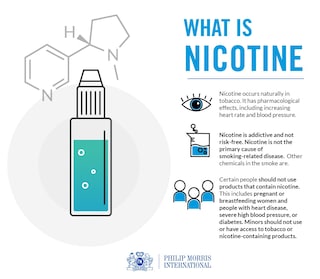What is nicotine?
Nicotine is a chemical that occurs naturally in tobacco, constituting around five percent of the plant by weight. It can also be found in significantly lower levels in other plant varieties of the nightshade family, including tomatoes, potatoes, and eggplants. It takes its name from French ambassador Jean Nicot, who sent tobacco seeds back to Paris in the 16th century. In its pure state, it is a colorless, odorless liquid with an oily consistency.

What is nicotine?
Percussion music starts
Title: What is nicotine
Nicotine occurs naturally in tobacco leaves and can be extracted by heating, burning or soaking the plant
Nicotine is addictive but is it not the primary cause of smoking related diseases.
Once inhaled, it is absorbed straight into the bloodstream where it travels through the body and to the brain
Nicotine binds itself to specific receptors and triggers the release of dopamine, which boosts attention but could also cause reward-seeking behavior.
Nicotine has short-term pharmacological effects, including increased heart rate and blood pressure.
It can take anywhere between 2 and 18 hours for nicotine to leave the body.
Nicotine should never be taken by adolescents, pregnant women or people with heart conditions
The best choice any smoker can make is to quit cigarettes and nicotine use altogether.
Smoke-free alternatives are only for adult smokers who would otherwise continue smoking.
They are not risk-free and contain nicotine, which is addictive.
Music ends
How is nicotine absorbed and how does it move through the body?
Products that provide nicotine include cigarettes and smoke-free alternatives. Some smoking-cessation aids also provide nicotine (nicotine replacement therapies) and include chewing gums and nicotine patches. Nicotine can be absorbed into the body through the lungs, mouth, or skin.
The way nicotine is absorbed determines the speed and intensity of its delivery. When tobacco smoke is inhaled via cigarettes, nicotine is absorbed through the lungs into the bloodstream and reaches the brain in 10 to 20 seconds. When absorbed through the skin via a patch—or through the mouth and stomach when chewing nicotine gum—nicotine is absorbed more slowly and therefore takes longer to reach the brain.
Once nicotine has entered the bloodstream, it modulates the reward systems, and is distributed to all tissues and organs, including the brain. There, it binds to specific receptor molecules, mimicking the actions of a naturally occurring brain chemical, acetylcholine. Nicotine is metabolized primarily by the liver, and is constantly cleared by the body.
Is nicotine addictive?
Yes, nicotine is addictive and is not risk-free, but it is not the primary cause of smoking-related diseases. Once nicotine has entered the brain, it modulates the reward systems. Once it leaves the brain, it can lead to withdrawal symptoms, for example when someone tries to quit. These withdrawal symptoms—which may include difficulty concentrating, anxiety, and dysphoria (commonly understood as distress and/or discomfort with life)—can affect many people when they initially quit smoking.
Nicotine replacement therapies and other cessation products can help address withdrawal symptoms. But nicotine is not the only factor relating to addiction. Other factors such as ritual, sensory experience, and social experiences all play a significant role.
While nicotine is addictive, it is possible to quit. Each year, millions of smokers succeed in quitting cigarettes and nicotine use altogether, which is always the best choice for health.
What is the role of nicotine in smoke-free alternatives to cigarettes?
Nicotine is one of the reasons that people smoke, along with other factors, such as taste and ritual. In order for adult smokers to switch from cigarettes to smoke-free alternatives, these products need to contain nicotine.
Of course, the best choice any smoker can make is to quit cigarettes and nicotine use altogether. Smoke-free alternatives are only for adults who would otherwise continue smoking.
Is nicotine bad for you?
Nicotine is addictive and not risk free. It is highly toxic when ingested or absorbed in high doses (beyond those typically found in regulated cigarettes, e-vapor, or oral smokeless products). Nicotine can also temporarily increase a person’s heart rate and blood pressure.
Although it’s not the primary cause of smoking-related diseases, certain people should not use nicotine. Minors should not have access to tobacco or nicotine products. These products should not be used by non-nicotine users, during pregnancy or while breastfeeding. They should also not be used by people with certain health conditions, such as severe high blood pressure, heart disease, diabetes, and those who are epileptic or who experience seizures.
As stated above, the best choice is to quit tobacco and nicotine altogether. Those adults who do not quit and who wish to continue using nicotine products should switch to a scientifically substantiated smoke-free product instead. These products are not risk-free and provide nicotine which is addictive, but they are a much better choice for adults than continuing to smoke cigarettes.




